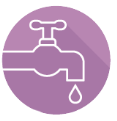To ensure we have sufficient water to meet the needs of all our consumers and put less stress on local water sources and the environment, we encourage customers to use the water wise ways.
Use Water Wisely
Below are more tips you can use to be water wise. Consider adopting these for both your indoor and outdoor water use. Help us spread the water wise message using the linked social media graphics.
Indoors







- Shower to save water. A bath typically uses up to 50 gallons of water, whereas a five-minute shower will use only 10-25 gallons depending on the efficiency of your showerhead.
- Keep drinking water in the refrigerator instead of letting the water run until cool. A running faucet can use about two gallons of water per minute.
- Turn off water while you brush your teeth and you can save as much as four gallons of water. If you brush your teeth in the morning and at night, that adds up to saving 200 gallons of water a month. The same is true when you wash your hands or shave.
- Scrape rather than rinse dishes before loading them into the dishwasher. The average dishwasher uses four gallons per cycle. A running faucet uses about two gallons of water per minute.
- Wash only full loads of clothes. Older top-loading machines use 40 gallons of water to wash a full load. Today’s newer standard models use 27 gallons, and more efficient ENERGY STAR washers use 14 gallons of water per wash.
- Pick the appropriate water level setting – often small, medium, large – for the load if that’s how your washing machine works. Front loaders and most high-efficiency top loaders have auto-load sensing, and a few of the latest agitator top-loaders have it, too.
- Verify that your home is leak-free. Read your water meter before and after a two-hour period when no water is being used. If the meter does not read exactly the same, you probably have a leak.
- Check your toilet for leaks by adding food coloring to the tank. If the toilet is leaking, color will appear in the bowl within 15 minutes. (Flush as soon as the test is done, since food coloring may stain the tank.) A leaky toilet can waste 200 gallons of water per day.
- Repair dripping faucets and showers. If your faucet is dripping at the rate of one drop per second, you can waste over 3,000 gallons of water per year.
Outdoors






- Never leave a garden hose running. A running hose can use up to 600 gallons of water in just a few hours. Keep a trigger-type nozzle on all outdoor hoses.
- Wash your car with a bucket of soapy water. Use a nozzle to stop the flow of water from the hose between rinsings.
- Don’t use a hose to spray away debris. Clean your sidewalk or driveway with a broom instead and save up to 80 gallons of water.
- Cover your spa or pool to reduce evaporation. An average size pool left uncovered can lose as much as 1,000 gallons of water per month.
- Nip that drip. Check for leaks in outdoor faucets, pipes and hoses.
- Water your lawn and garden early in the morning or in the evening and never on a windy day. This will avoid water loss to evaporation when the sun is at its highest. Using a sprinkler that sprays large droplets rather than a fine mist will also reduce loss of water due to evaporation.
- Water your lawn and garden, not the driveway. Adjust your sprinkler so water is aimed directly at plants rather than the house, sidewalk, driveway or street.
- Only water when your lawn is thirsty. Overwatering promotes shallow root growth making your lawn less hardy. One simple way to tell if your grass needs water is to step on it. If it springs back, there is ample moisture. If it lies flat, it needs water. Watering your lawn deeply instead of frequent, shallow watering encourages deep root formation which will help your lawn be more resistant to drought and disease.
- Mulch, mulch, mulch! This is one of the most important aspects of keeping the water you apply to your plants in the soil instead of evaporating into the air! Mulching also reduces weed growth and weeds competing with your plants for water. You can use woodchips, pine straw, shredded newspaper or many other types of materials.
- Don’t mow too close. Maintain a lawn height of three to four inches to help protect the roots from heat stress and reduce the loss of moisture to evaporation.
- Plan your landscape. Cluster plants with similar water requirements together. Designate zones for areas requiring frequent watering, occasional watering and no watering. Match plants to yard conditions such as sunny, shady, dry or damp.
For more information on using water wisely go to the EPA’s WaterSense website and check out this water calculator.


